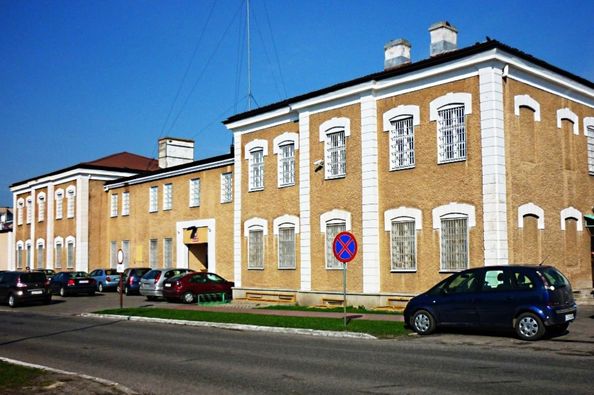
May 8, 1946 - Zamość - Communist prison is broken into. Release of prisoners.
May 8, 1946 - The communist prison in Zamość is broken in.
The release of 301 or 346 prisoners
May 8, 1946 - The communist prison in Zamość is broken in.
The release of 301 or 346 prisoners
Preparations for it began in the first half of April 1946. The underground authorities decided to execute it because of the arrest and imprisonment in prison cells of many local conspirators who underwent brutal investigations conducted by officers (Security Office) - UB.
The decision to carry out the action was made by the commander of the Zamość District of Freedom and Independence (WiN), Capt. Marian Pilarski pseudonym "Jar", while the commander of the District "Jaśmin" (Stary Zamość), Lieutenant Roman Szczur pseudonym. "Ursula". It was not a random choice, because Szczur (who also used the name Szumski) was a seasoned underground soldier. He gained military experience even before the outbreak of World War II. In the years 1931–1932 he served in the 23rd Infantry Regiment in Włodzimierz Wołyński, later in the Battalion of the Border Protection Corps (KOP) "Stołpce", and then, until the outbreak of the war, in the 52nd Infantry Regiment of Borderlands Rifles. In September 1939, he was taken prisoner by the Soviets, from where he escaped, returned to his homeland in the Zamość region, and joined the structures of the conspiracy that was being formed there. From the spring of 1941, he commanded the posts of the Union for Armed Struggle (ZWZ), and later the Home Army (AK) in Nielisz and Stary Zamość. During the occupation, he participated in many skirmishes with the Germans, subversive actions, and liquidation of people collaborating with the occupant. In the spring of 1944, "Urszula" was appointed a training non-commissioned officer in his region of the Home Army.
The invasion of the Soviet troops and the installation of the Polish communist government under the sign of the Polish Committee of National Liberation were often associated with the arrest of underground soldiers. Former German camps and prisons were quickly filling up with members of the underground held by communist torturers. Zamość was no exception here. The Czerski tenement house at ul. Żeromski was from 1940 the seat of the Gestapo, from the fall of 1944 the cells were used by the Soviet NKVD, and from January 1945 by UB functionaries. It was similar to the prison at ul. Okrzei in Zamość.
Roman Szczur ps. "Urszula" was still in the underground, performing the function of the commander of the Home Army-DSZ post in Stary Zamość until September 1945. In addition to storing weapons and intelligence activities, he also took part in armed actions against the communists. He found himself in a group led by Lt. Edward Błaszczak, the pseud. "Grom", on October 7, 1944, was released from the prison in Zamość a group of over 30 prisoners of NKVD and UB. Among others, Lieutenant Jan Turowski pseud. "Norbert", commander of the Home Army partisan unit, and Second Lieutenant Józef Kaczoruk pseudonym "Ryszard", commander of the partisan unit of "Wiklina".
In the preparations for the action, it was crucial to conduct an interview in the prison, in which several people were involved. One of them, Irena Mendykówna pseud. "Żaneta", who worked in a court in Zamość, had many acquaintances among the prison staff. Extremely valuable information was provided by the prison guards - elderly, sixty-seven-year-old, Roman Sebastiani and Jan Radziejowski. Former prisoners were also very eager to share their knowledge about the arrangement of corridors and the arrangement of cells. Detailed research allowed "Ursula" to prepare a detailed plan of the attack. A date was also set - Wednesday, May 8, 1946, on the eve of the Victory and Freedom Day established by the National Council, which was then a day off from work.
12 to 18 soldiers from the posts of Udrycze, Wisłowiec, and Sitaniec were to take part in the action. Everyone gathered near the sawmill belonging to Zygmunt Zipser, from where they went to the forest near the city. Here, Lieutenant Szczur presented a detailed plan to break the prison and assigned tasks to his subordinates, but the key task fell to "Urszula" and to Stanisław Bizior, pseud. "Propeller". Luckily, it started to rain in the evening, and the guard, Seraphim Nadra, on watch outside next to the gate, entered the guard booth. After 21.00 Rat and Bizior overpowered him and disarmed him, and then waited for the return of two other officers - brothers Jan and Józef Kościk (who were at supper outside the prison), who also took their weapons away.
All three were led to the prison gate, where the guard opened the gate when he saw Jan Koscik through the peephole. Immediately a strike group stormed in and headed for the duty room, where two guards were killed during the fight. The office was also seized, in which the warden of the prison, Wawrzyniec Siwiec, and two other officers were disarmed. At the same time, in the guardhouse, one of the guards grabbed a pepeshka from a rack, ran into the corridor and opened fire on WiN men, killing Edward Świst pseudonym. "Miś" and wounding Stefan Policha pseud. "Krasnopolski", however, also died at the hands of the attackers. The Kościk brothers took advantage of the confusion, one of whom escaped to the chief's apartment, and the other hid in a pigsty, in outbuildings outside the prison wall. The partisans took the keys from the guardhouse and ordered one of the guards to open new cells and release the prisoners. Due to the insufficient number of people taking part in the action and the lack of time, Roman Szczur gave up his original intention of conducting a selection of inmates and leaving Germans, collaborators, UPA and common criminals in their cells. All, 301 prisoners in total were released.
The perfectly planned and conducted action was successful with minor losses (1 killed, 1 wounded). Interestingly, the head of the prison, Wawrzyniec Siwiec, in his report of May 10, 1946, wrote that 100 underground soldiers took part in the attack. His superiors had a different opinion on this subject, showing him a number of negligence.
Unfortunately, most of the participants and organizers of the action were later murdered by the communists. Roman Szczura pseudonym Urszula was executed on January 23, 1950, in Wrocław. Marian Pilarski ps. "Jar" and Stanisław Bizior pseud. "Eam" were murdered in the Castle Prison in Lublin on March 4, 1952. In turn, one of those released from the Zamość prison - Józef Pyś pseud. "Ostry" died in Zamość from wounds sustained in the fight against militiamen in February 1951.
For many years their burial places were unknown. As a result of search work carried out by the Institute of National Remembrance, their remains are found in many places in Poland and then ceremonially buried. In the Zamość region, the basilica of the Bernardine Fathers in Radecznica is an exceptional place. It is in the basement of this temple that there is a crypt of steadfast soldiers, in which, among others, Marian Pilarski ps. "Jar", Roman Szczur pseudonym "Urszula", Stanisław Bizior pseud. "Eam" and Józef Pysia pseud. "Sharp".
Ostatnio
dodane komentarze
Ten artykuł nie ma jeszcze komentarzy.
Categories
- Current issues
- Beginning of World War II
- German occupation
- Soviet occupation
- Soviet Union
- Biographical notes
- Heroes
- Villains
- Podcasts
- Documentaries
- Second Polish Republic
- Third Polish Republic
- Soviet German relations
- Polish Armed Forces in the West
- Polish Jewish relations
- Polish Ukrainian relations
- Polish American relations
- Polish British relations
- Non-Polish related
Login

Who am I? Get to know me closer
I am using this platform to continue the battle against revisionism and propaganda. Poland fought and suffered and are now being attacked in a variety of ways for various agendas.
In the name of historical accuracy and truth, we must respond.
Jews & Poles Database
Check the compendium of informations about Polish-Jews relations and encounters.
MoreLatest
articles
Latest
comments

In a time of universal deceit, telling the truth is a revolutionary act
- George Orwell
Dodaj
komentarz
By dodać komentarz musisz być zalogowany. Zaloguj się.
Nie masz jeszcze konta? Zarejestruj się.